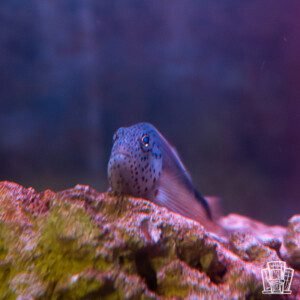Description
-
- Scientific Name: Ctenochaetus truncatus
- Common Names: Indian Gold-ring Bristletooth, Squaretail Bristletooth, Yelloweye Bristletooth
- Maximum Length: 6.3 inches (16 cm)
- Minimum Aquarium Size: 100 gallons (379 liters) for a single fish. Their grazing habits require ample rockwork and swimming space.
- Foods and Feeding Habits: Herbivorous, grazing on algae and detritus in the wild. In aquariums, offer nori seaweed, spirulina-based flakes or pellets, and small crustaceans like mysis or brine shrimp. Feed 2-3 times daily, ensuring plenty of algae growth in the tank for natural foraging.
- Reef Safety: Reef-safe; they help control algae without harming corals or most invertebrates.
- Temperament: Mostly peaceful but may be aggressive toward similar tangs or surgeonfish. Best kept singly in mixed communities with non-aggressive tankmates.
- Description: The Squaretail Bristletooth is a practical algae grazer for marine tanks. Its body is brownish with blue or gold spots, a short square tail, and bristle-like teeth for scraping surfaces. Native to the Indian Ocean, from East Africa to Indonesia, they inhabit sheltered reef crests and slopes among corals at depths of 1-21 meters. Juveniles start bright yellow before developing spots. Hardy once acclimated, they add subtle activity and utility to the aquarium.
Fun Facts:
- Part of the Ctenochaetus strigosus complex, it has three look-alike siblings in different oceans, showcasing evolutionary divergence: C. strigosus in Hawaii with a gold eye band, C. cyanocheilus in the central Pacific with a white tail, and C. flavicauda in the southeastern Pacific also with a white tail.
- While adults roam shallow reef crests, juveniles prefer deeper, coral-rich waters as nurseries, aiding survival by avoiding competition and predation. 8
- Their specialized bristle-like teeth can move individually, allowing them to sift, sort, and scrape algae and detritus from uneven surfaces with remarkable efficiency.




